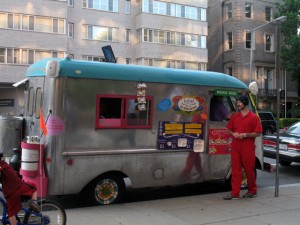It’s also a defining characteristic of an area’s architecture and culture. Looking at this area, again, you can see nodes and corridors arising from the shapes, not consistent, and lacking in almost any east-west traffic. It also reminds you that the vast majority of the area is housing only, even many of the apartment buildings.
Tag: streetlife
Eatable things: Fojol Bros. of Merlindia

The Fojol Brothers of Merlindia, a quartet of locally grown twentysomethings with a secret indian chef, are out to revolutionize the street food scene in DC. Along with Ali Baba’s, and the upcoming Sweetflow truck, they’re up against DC’s longstanding tradition of awful, awful street vendors. As one (I think it was Ababa-Du) told me, “All you get in DC is hot dogs and soda … yeah and awful pretzels.” Awful pretzels indeed, and without dijon. Running only on Fridays and Saturdays, all of the members do this in addition to regular jobs and apparently are willing to sacrifice their weekends to bring their traveling culinary carnival to DC.
Their total aesthetic is a retro fusion of Indian with hip green techno, employing fake mustaches and turbans while they cruise around in a 1960s bread truck. Their trays are made out of sugar cane fibers, their sporks from corn resin, and they compost just about everything else. All of this half-ironic campiness and doo-goodery could be a pretty lame excuse for attention, were it not executed with such batty genius – and more importantly, if their food wasn’t so good.
It can’t be stressed enough that the food is delicious, basic Indian food. Fretting about authenticity of cuisine is always a bit misplaced, but with complex food from a made-up place, you should just shut up and eat. I had the chicken masala, a pumpkin side, and some sweet sticks. The chicken was a moderately spicy dish that satisfies like any indian food with sauce, while the pumpkin was soft and delicious, with a heavy dose of cardamom that balanced the sweetness of the fruit itself. The sweet sticks were not so much sweet as they were flavored with cumin and maybe allspice, which made them pretty good for cleaning out the lingering masala spices.
As I sat there eating, I watched the stream of buttoned-down passers-by giving long, curious looks and other people lingering and plenty eating. It’s never going to be like New York, with its hour-long waits at 53rd & 6th chicken and rice, the ultimate drunk food that is Roti Roll, or the Vendy awards, but this little performance-food experiment is definitely a good thing, and hopefully a sign of things to come.
Follow them on twitter and get to eating.
